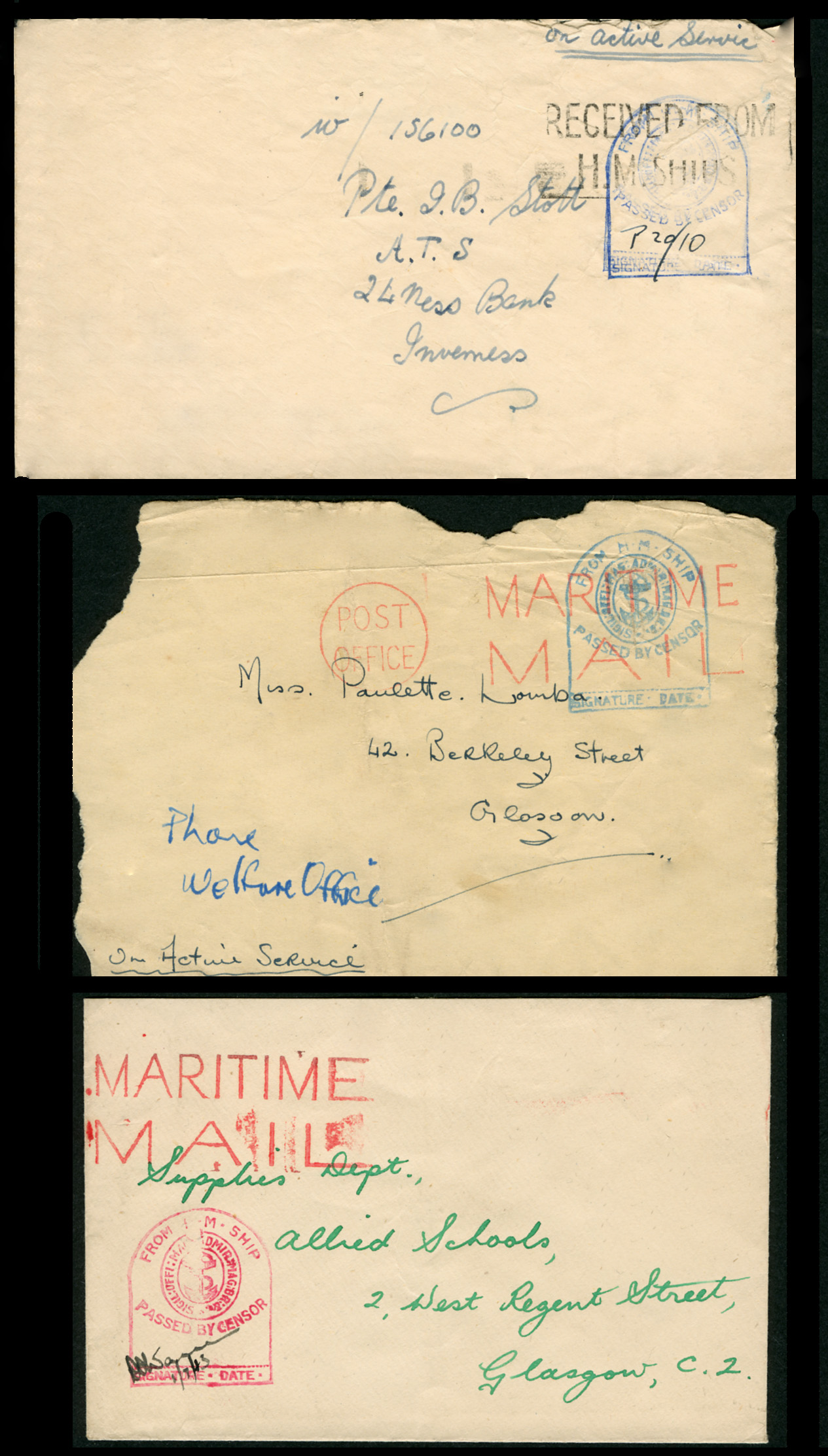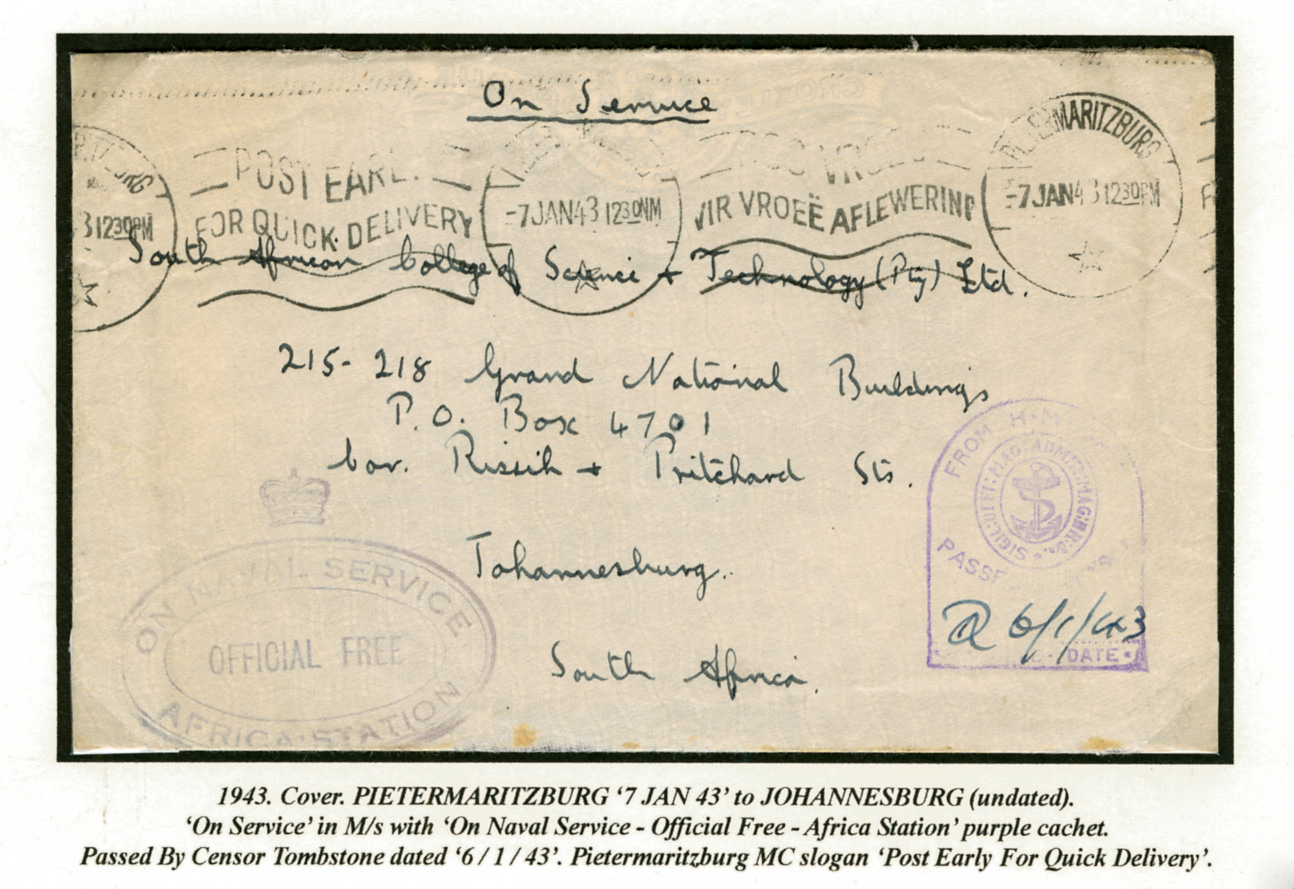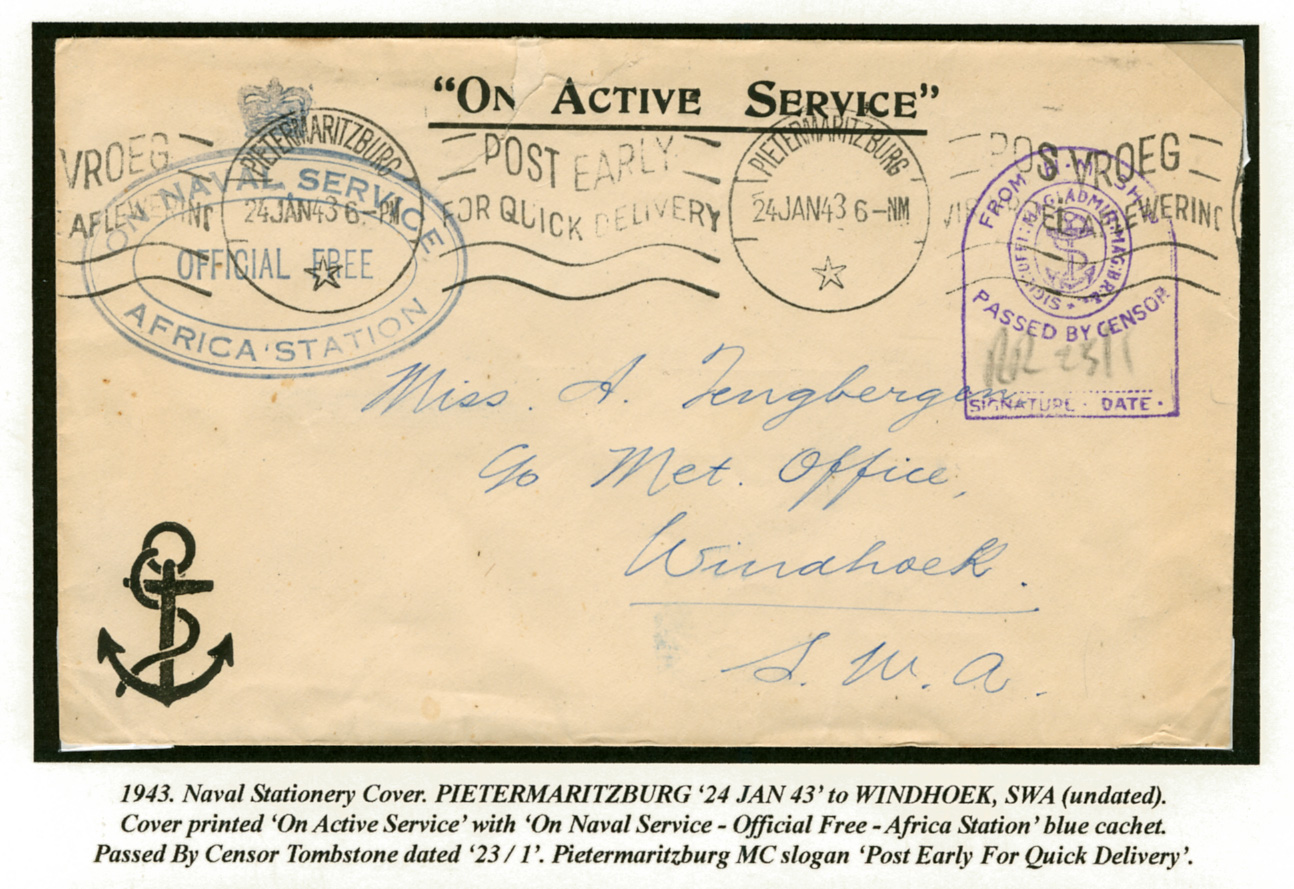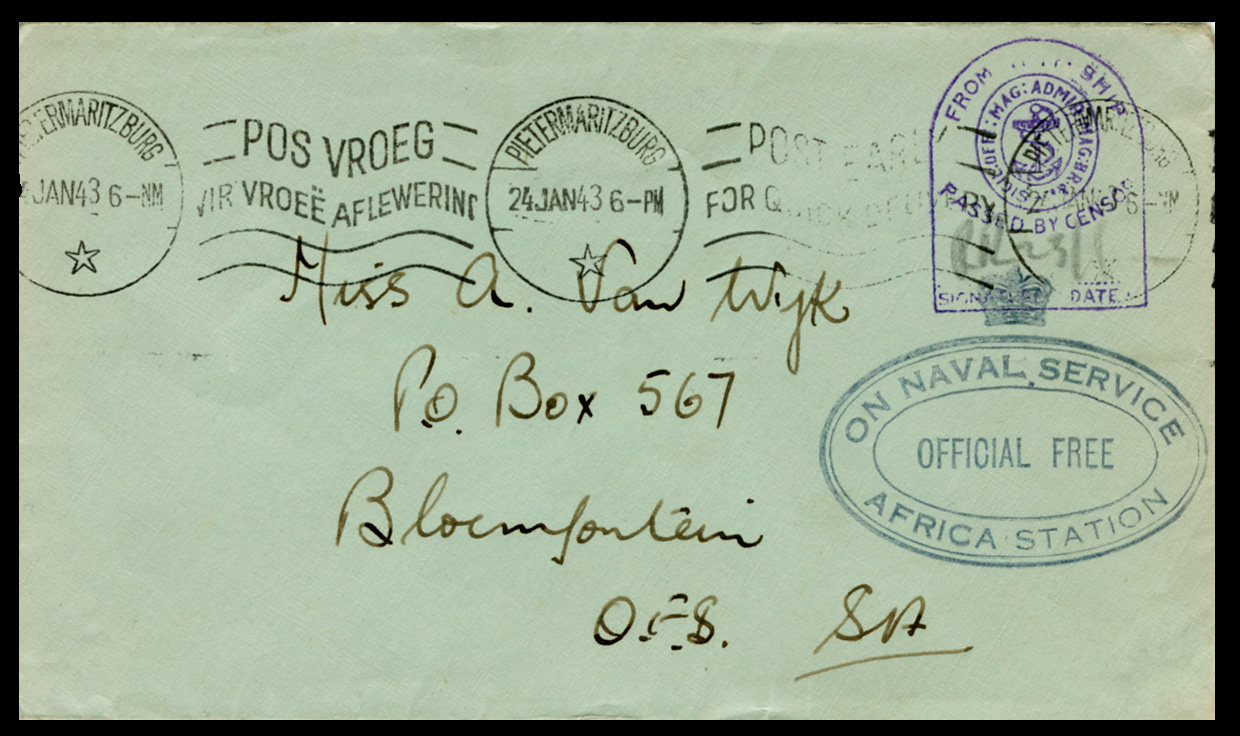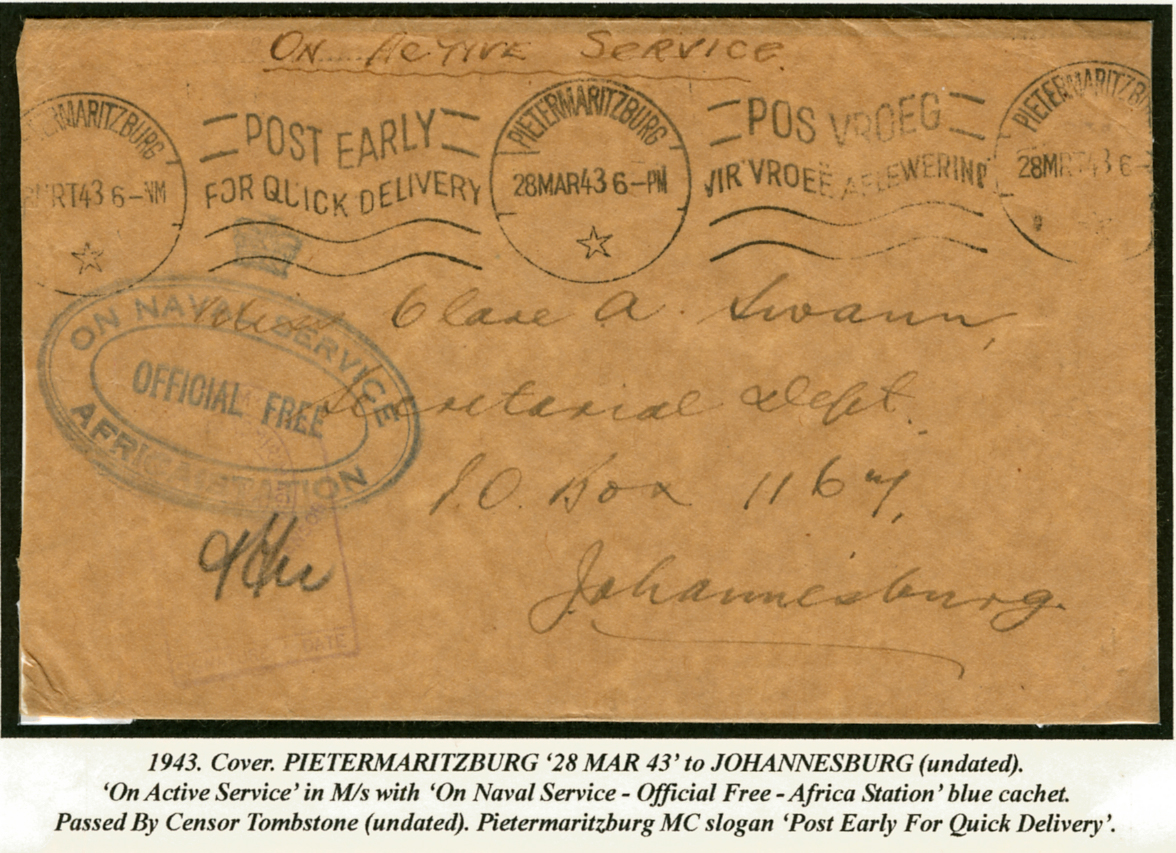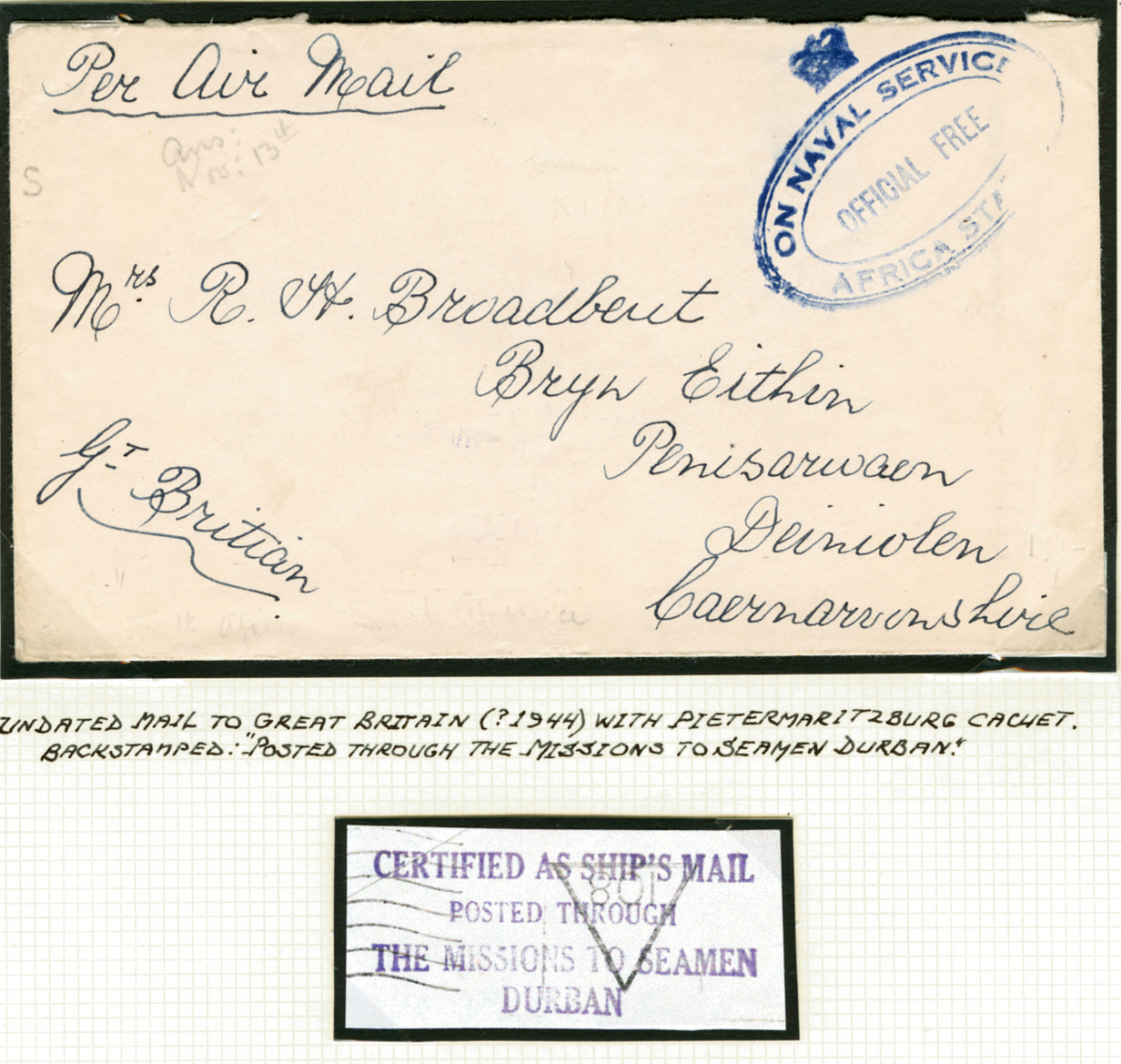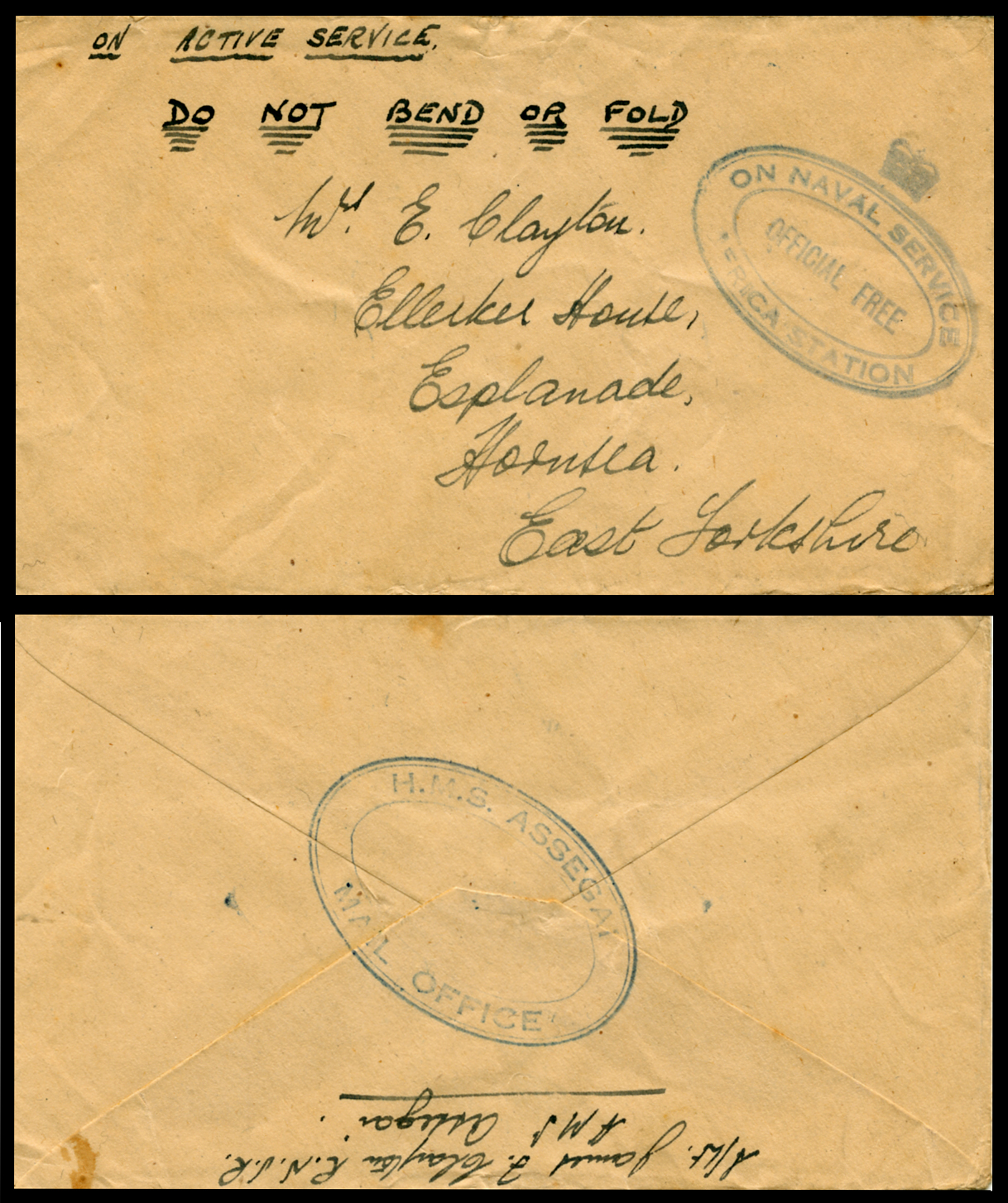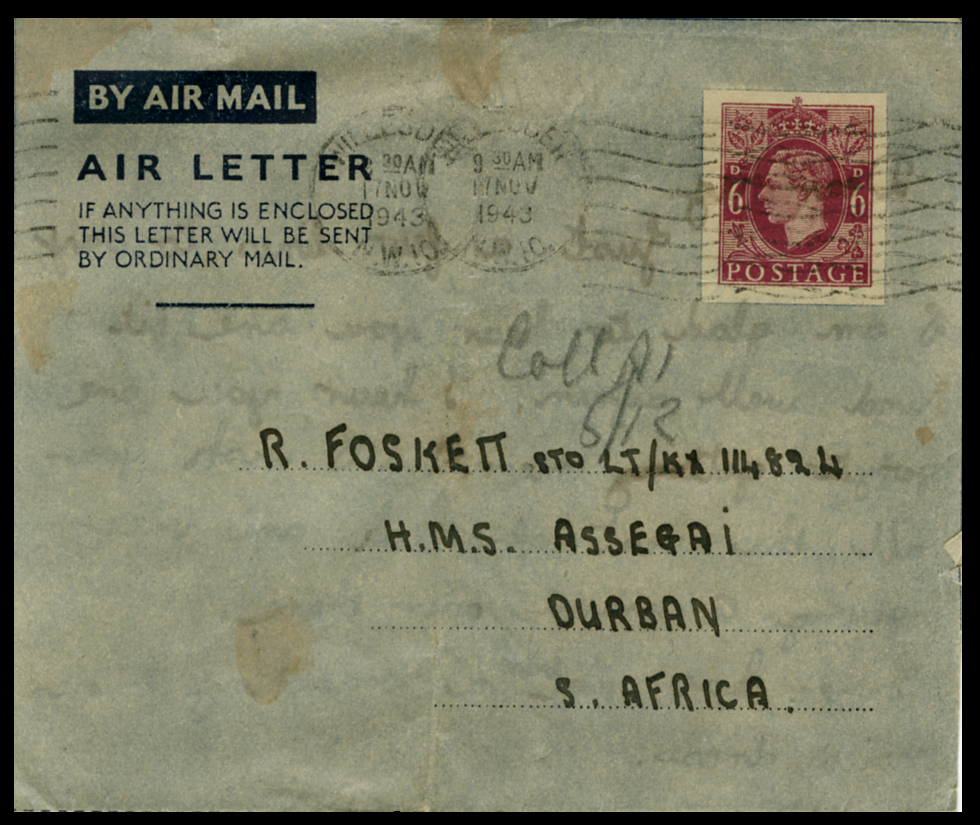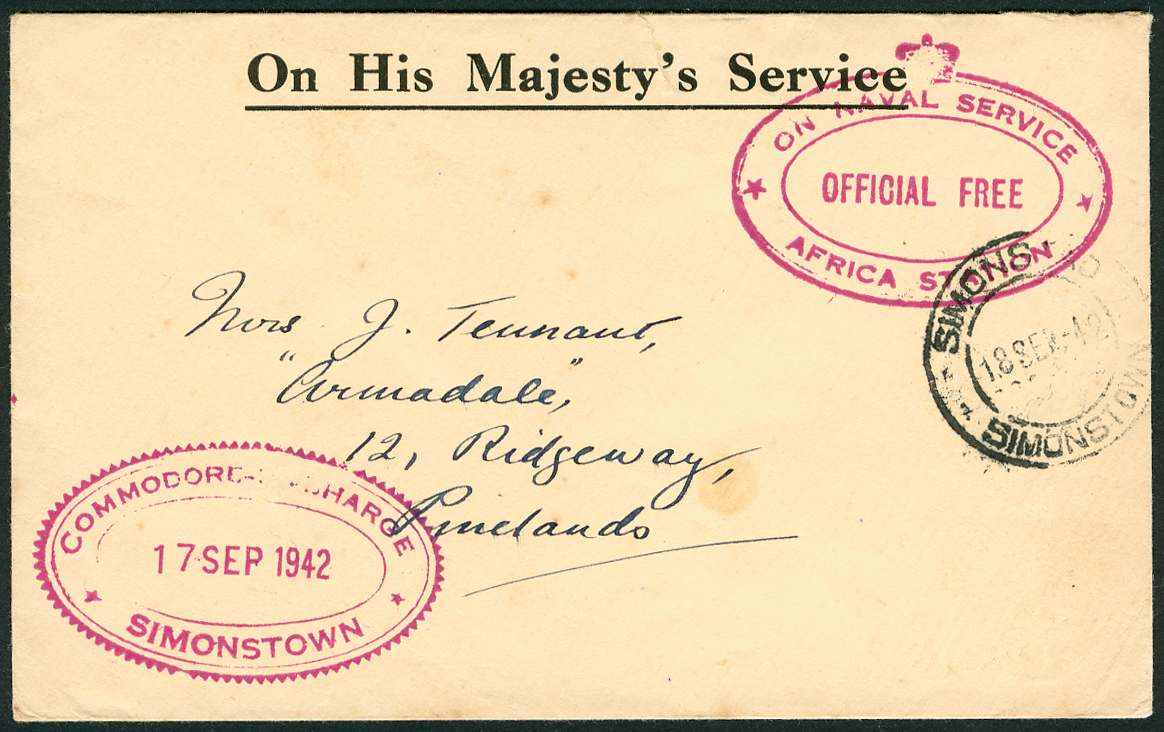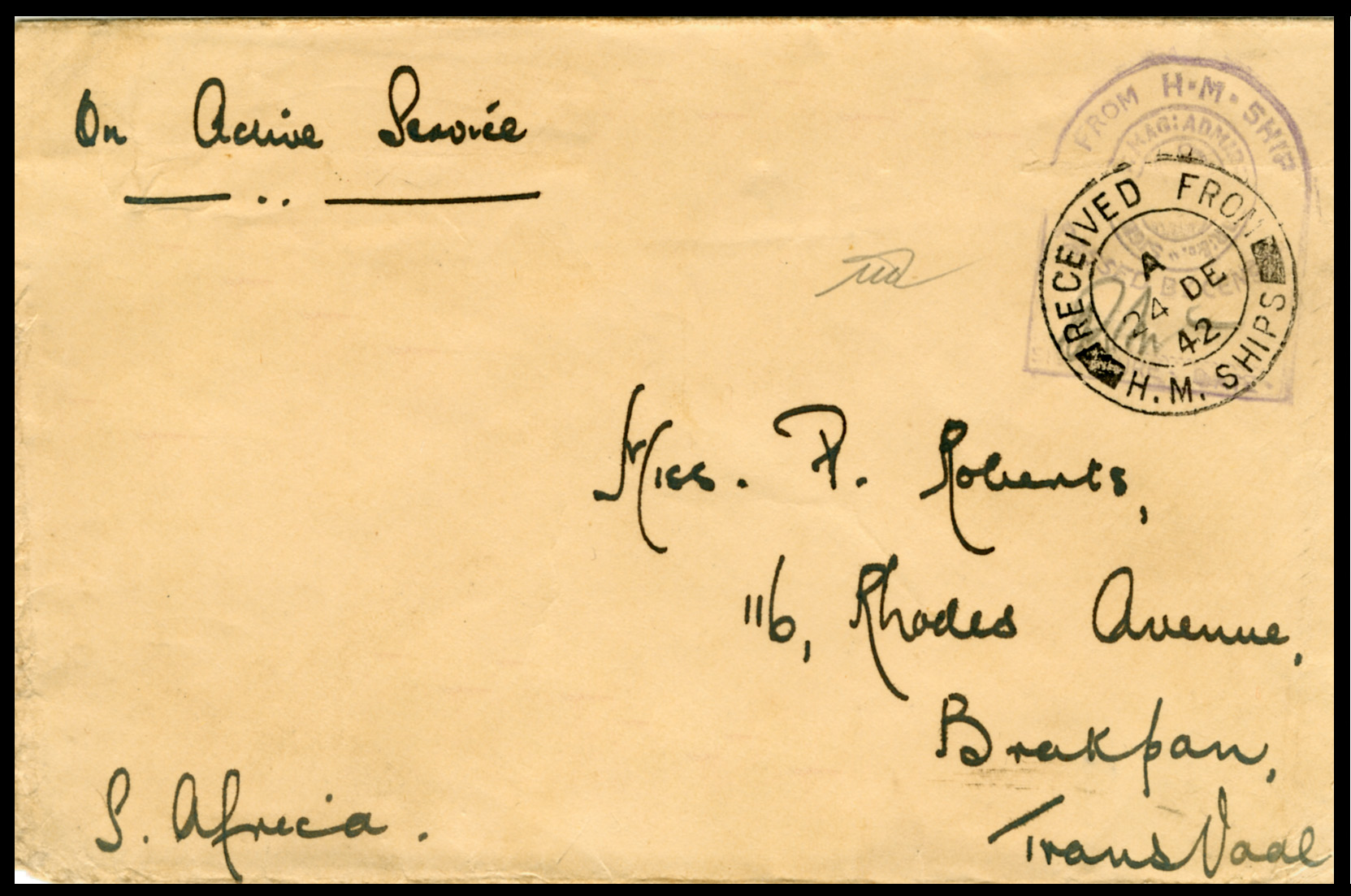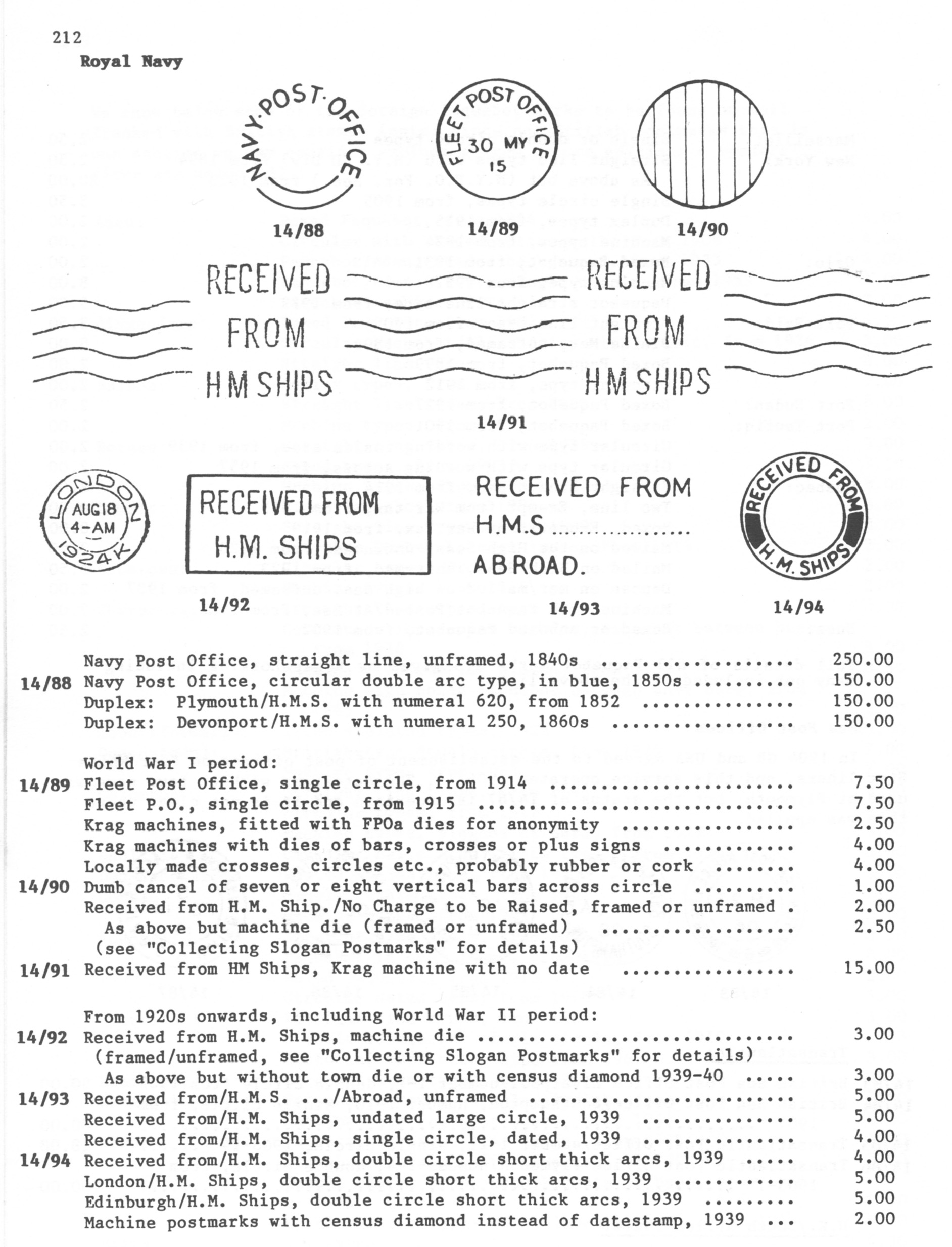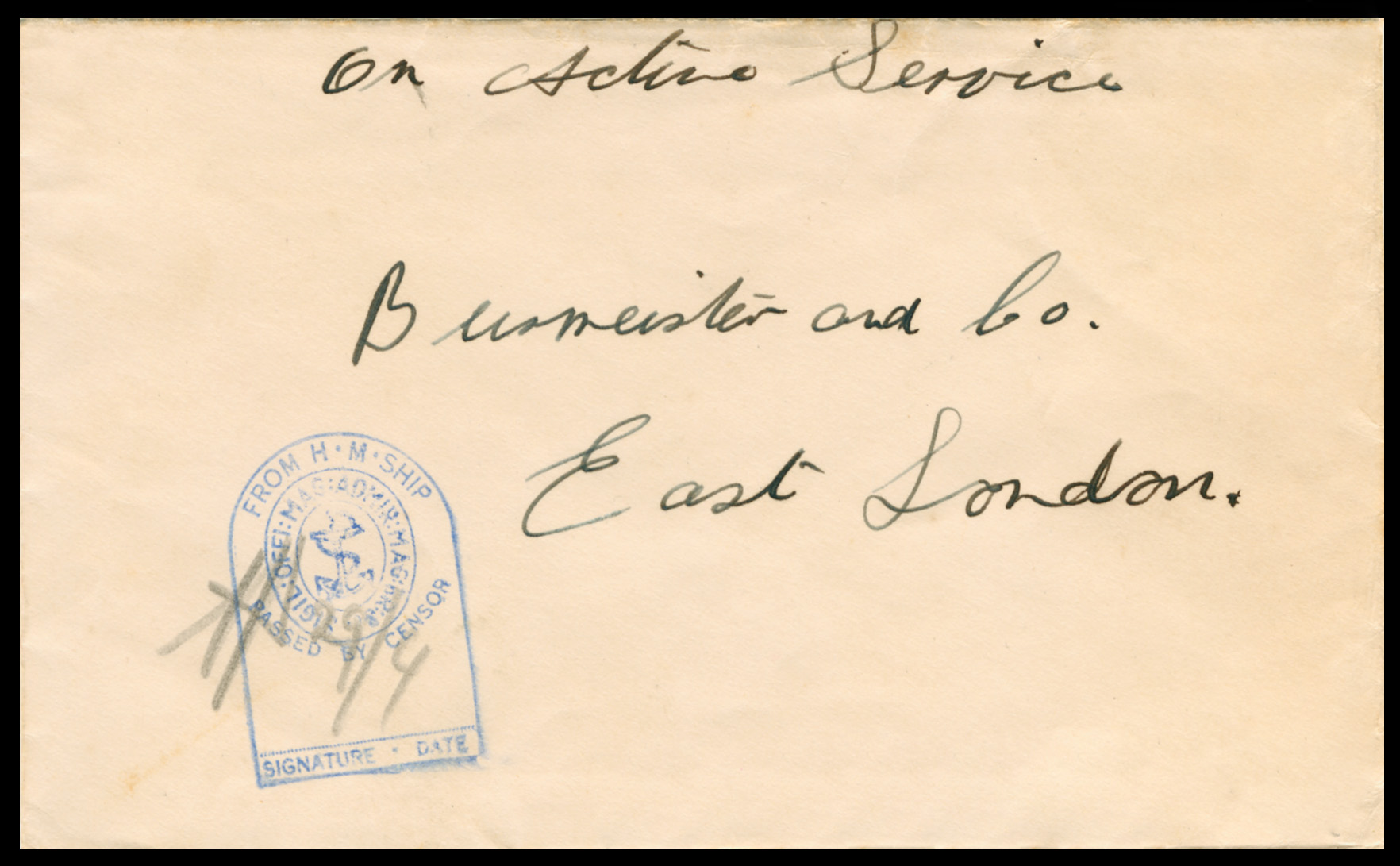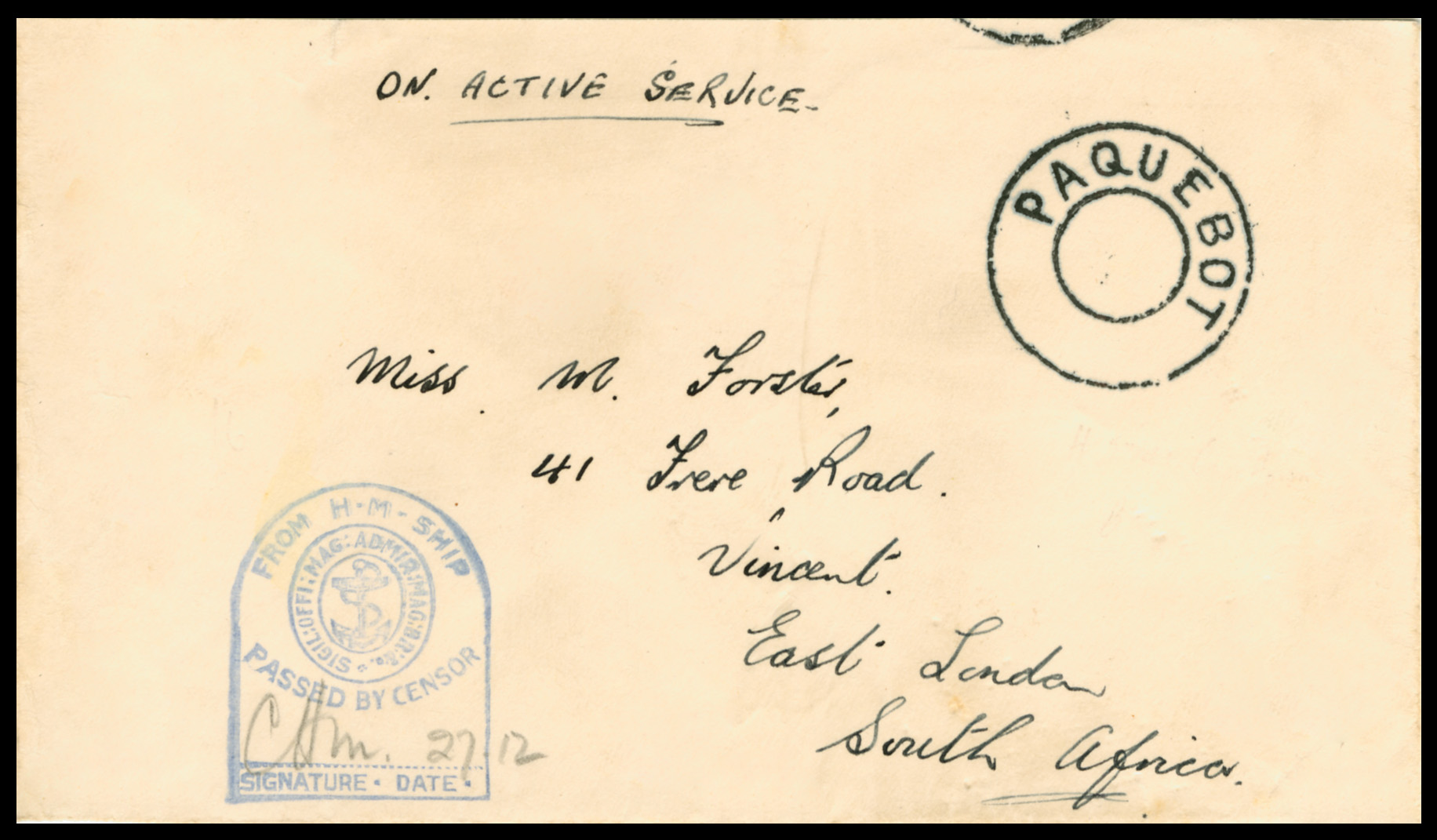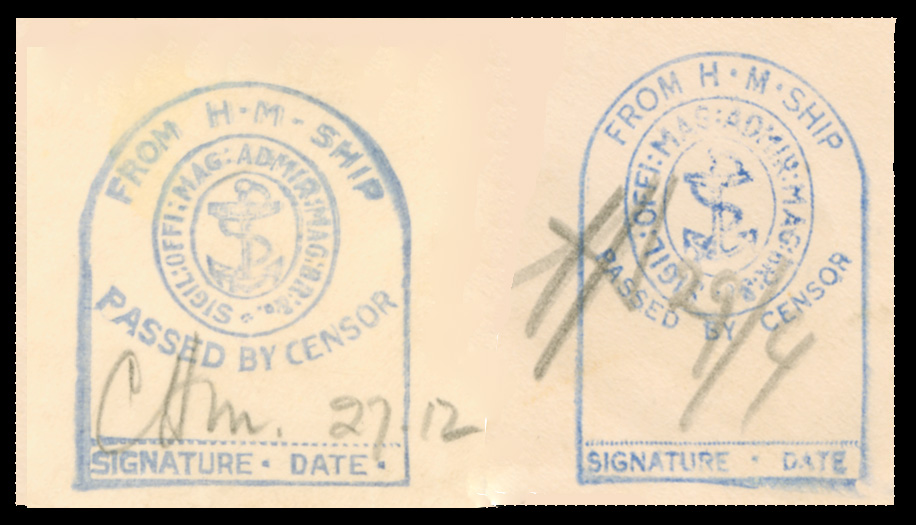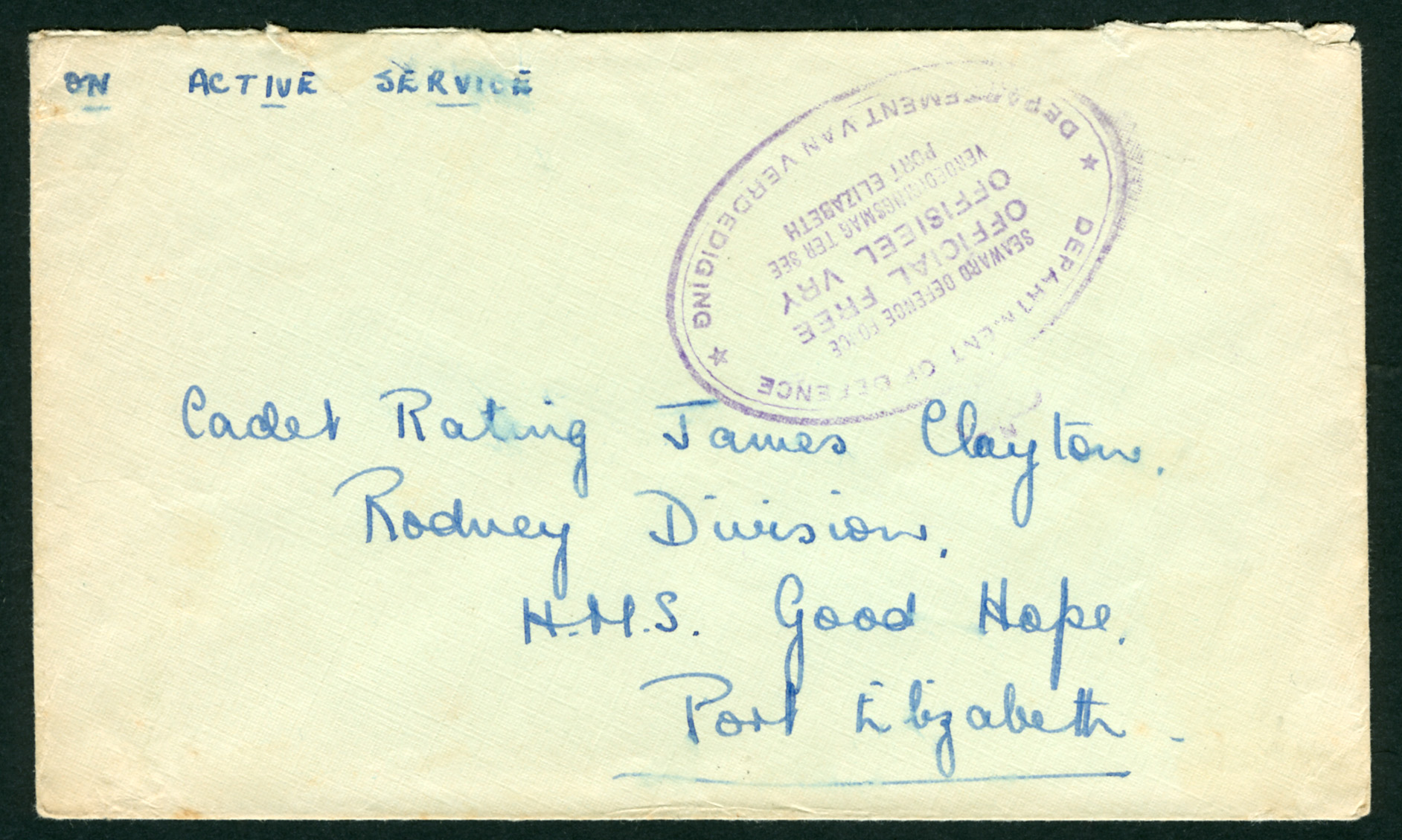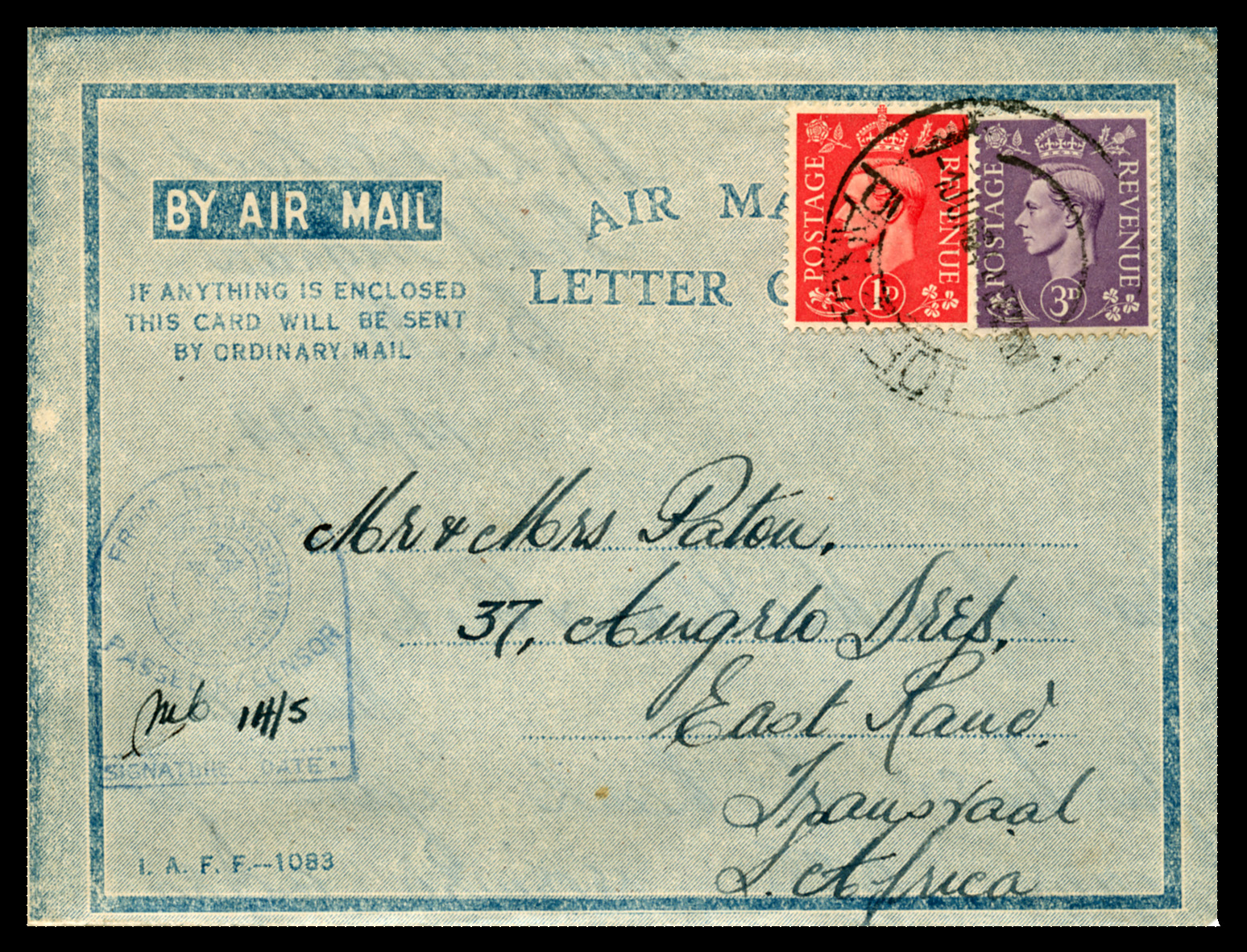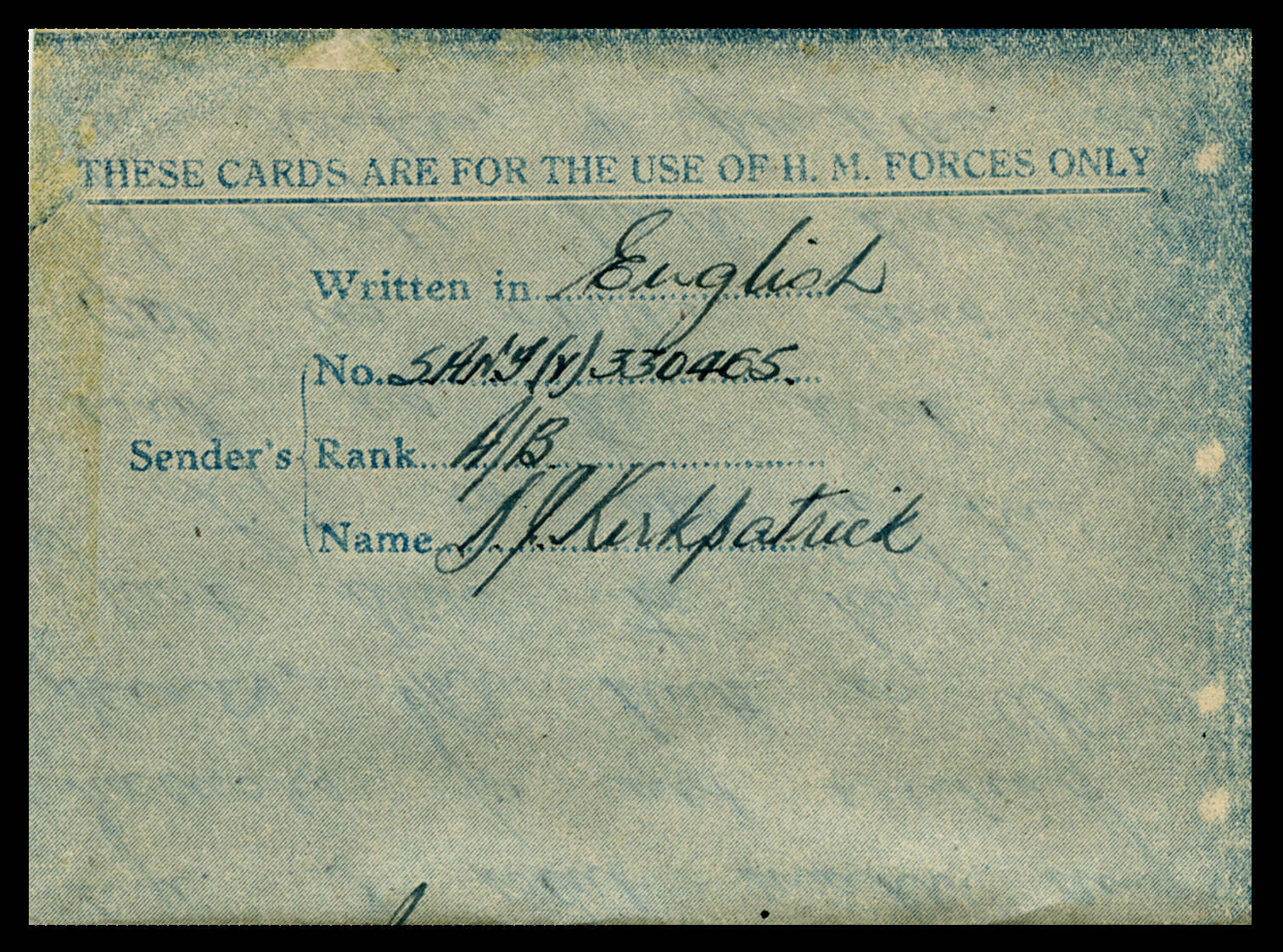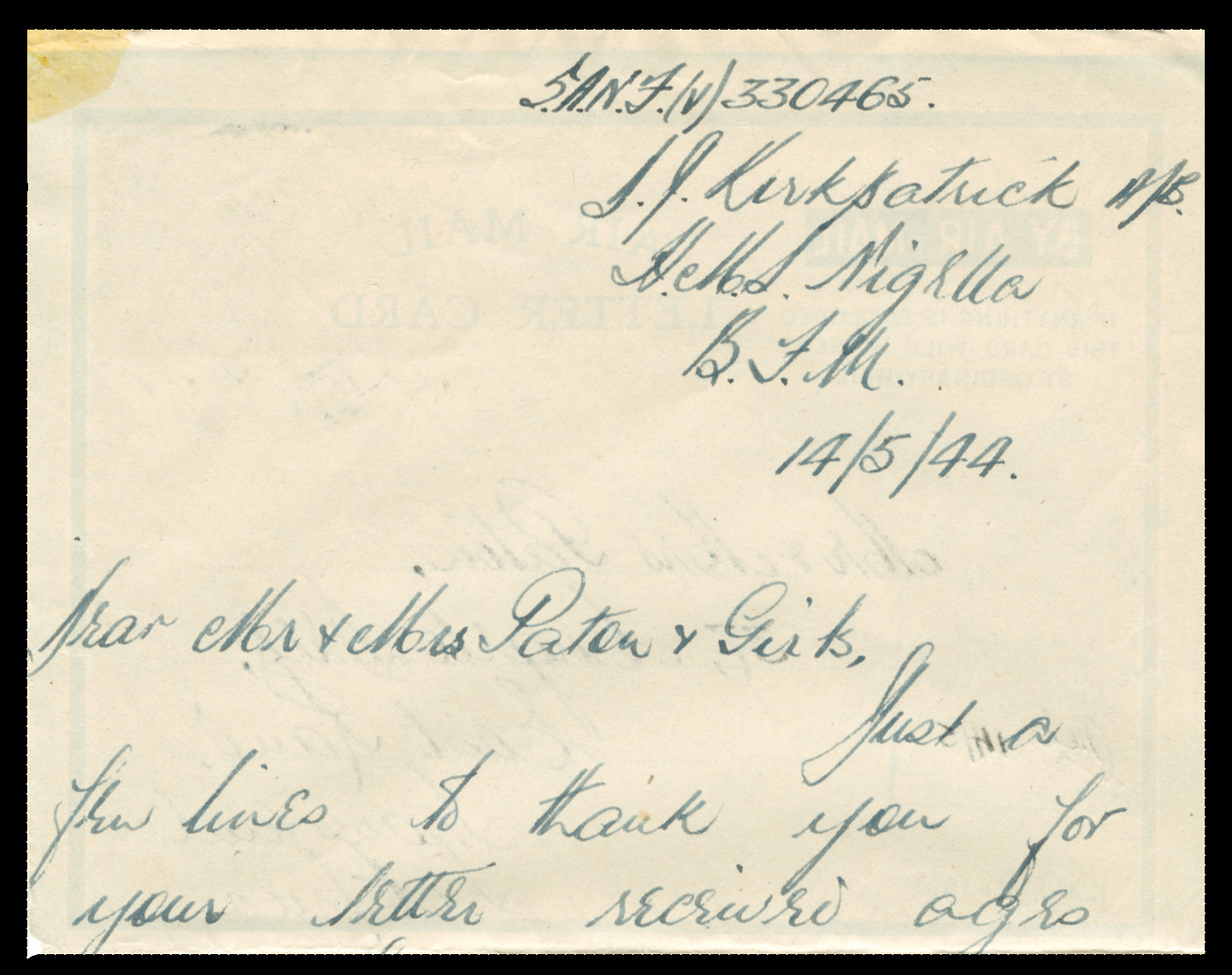Royal Navy Tombstone Censor Marks used in South Africa
Quote from Steve on November 11, 2022, 8:41 amBy 1940 all British Royal Navy ships had been supplied with the new Tombstone censor mark which insured free mail privileges to the ships' crews. Tombstone censor marks were also issued to the Royal Navy's shore-based 'stone frigates'. In South Africa these included HMS Afrikander at Froggy Pond, Simonstown; HMS Assegaai in Durban and the Royal Navy Mechanical Training Centre in Pietermaritzburg. I believe but cannot prove that one was supplied to 'HMS Good Hope', an Officer Training Centre in Port Elizabeth. I am hoping that this thread will prove the use of Royal Navy Tombstone censor marks in Port Elizabeth and elsewhere in South Africa.
A bit of background, briefly....
In 1743, Simon's Bay, later Simonstown, was used by the Dutch to shelter valuable VOC fleets from the devastating north-westerly gales that battered Table Bay in winter. In 1813, some seven years after the Second British Occupation of the Cape, the Royal Navy also decided to relocate from Table Bay to Simon's Bay. Over time Simon's Bay became known as Simonstown (today Simon's Town). By the mid-19th c. its naval base was officially referred to as the 'Cape Station'. A new naval harbour was built at great expense and opened in 1910. Despite being re-designated the 'Africa Station' in 1920, the Simonstown naval base continued to use both a ‘Cape Station’ or an ‘Africa Station’ cachet on its mail right up until the mid-1950s. (During WW2 Durban would also use an oval 'Africa Station' cachet.)
With a direct rail connection from the Union's PWV (Pretoria - Witwatersrand - Vereeniging) industrial triangle, Durban was the Union's most important port of export. During WW2 its strategic position on the south-east coast arguably made it more important than Simonstown. It was of vital importance to the Allied war effort as the Royal Navy fought for control of the Indian Ocean where Japanese submarines lurked attempting to sink ships taking vital South African-made munitions up the Mozambique Channel to the battlefields of North Africa and or across the Indian Ocean to those in South-East Asia. It is not generally known but a Japanese submarine flew a reconnaisance plane over Durban - twice! At the Battle of Alamein in 1942 the majority of artillery shells fired by the 8th Army were made in South Africa, all shipped out via the port of Durban. As a consequence, there was a large Royal Navy presence in Durban.
After the Battle of the River Plate in December 1939, the 'Africa Station' in Simonstown ceased to be a command operations center and senior naval were staff relocated to the newly formed South Atlantic Station headquartered at Freetown, Sierra Leone. It was hoped that this would strengthen the Allied hand in the looming Battle of the Atlantic, the belief being wrongly that German U-boats and surface raiders would not venture beyond the Cape. As a result, command of Simonstown was transferred to the Commander-in-Chief, South Atlantic Station in Sierra Leone. The Simonstown naval base remained a part of that command until the British government handed the navy base over to the Union Government and the South African Navy in 1957. During WW2 Simonstown continued to use both 'Cape' and 'Africa Station' cachets while Durban and Pietermaritzburg used an 'Africa Station' cachet.
The “Tombstone” handstamp
"At least 90% and probably more of all WW2 RN censors are of the tombstone type."
(Colin Tabeart, Forces Postal History Society).Image 1 below.
This shows three covers to GB originating from HM Ships at sea. It is not possible to say if any of these originated in South Africa, most probably not. They are typical of the wartime use of the Tombstone censor mark. These are handstamped in blue and red. Black is also seen. The top cover has been censored by an officer and marked 'P 20 / 10' within the Tombstone. (Curiously, the sender appears to be a soldier, not a sailor.) The second, like the first, is marked 'On Active Service' but the third is not. It was not a requirement to write 'On Active Service' - the Tombstone guaranteed free post - but many did. Unlike the first no officer has signed or initialled the second. The third in red has been signed and dated '1 7 43'. All three covers have been received in GB by either a 'RECEIVED BY H.M.SHIPS' or a 'MARITIME MAIL' machine canceller. There is little to say where they came from. Sssh! Loose lips sink ships!These were introduced in December 1939 to meet naval requirements for censorship with HM Ship anonymity. It was applied both aboard a ship at sea or in port as well as in naval bases ashore. By 1940 all Royal Navy ships were supplied with the new Tombstone censor mark which insured free mail privileges to the ships' crews. It is not yet known exactly when these entered service in South Africa. Curiously, the three Pietermaritzburg covers with Tombstone censor mark below are all dated January 1943.
Vessels purchased from the Royal Navy and or built for the Royal Navy and manned by Dominion personnel were also equipped with the Tombstone censoring device. As shore-based 'stone frigates' HMS Afrikander (No.s 1 & 2) in Simonstown; perhaps Cape Town (3); and its counterpart HMS Assegaai in Durban received the Tombstone censor handstamp. Some suggest that Durban's HMS Assegaai included the Royal Navy Mechanical Training Centre in Pietermaritzburg. If it did, it is most likely that each facility was issued with its own Tombstone censor mark which they used independently of the other. If only Durban possessed the mark, Pietermaritzburg's mail would have had to go to Durban for censoring before being returned to Pietermaritzburg for posting. This would have been hugely impractical.
As there is little or no difference between the marks used in Simonstown, Cape Town, Durban and or Pietermaritzburg, other than the censoring officer's initials and a date often without year, it is a tricky matter to determine their origin. This is because the Tombstone cesnor mark is often the only postmark on the cover. Fortunately, dumb datestamps were sometimes applied to the cover. The purpose of dumb' datestamp was to conceal the port of origin but, ironically, being well-documented today they often provide a good clue as to where they were used. Another more obvious pointer is an address, something that SA's shore-based 'stone frigates' allowed towards the end of the war but which is almost never found on ship mail. 'While the use of 'Cape Station' indicates Simonstown, possibly Cape Town, the use of 'Africa Station' can be anywhere. Fortunately, there are some indentifiable differences between the various Cape and natal use of 'Africa Station' cachets.
As a Simonstown collector it has taken me some time to lose my sea legs and find satisfactory proof of the Tombstone censor mark's use on South African soil. The covers below show undoubted use in Pietermaritzburg. Sadly, such clear and obvious proof is the exception, not the rule. Elsewhere in South Africa the use of the Tombstone censor mark in visiting ships and land-based 'stone frigates' is not a straightforward subject well-supported with obvious marks and easily available facts. This is a work in progress.
Your comments and corrections with images on this subject will be gratefuly received.
Image 2, 3 and 4
Below are some 'Tombstone' / 'Africa Station' covers from Pietermaritzburg clearly linked to their point of origin. Perhaps the most remarkable feature about them is that there appears to be no attempt at hidng their origin, perhaps because you can't sink a 'stone frigate' based 42 miles inland from Durban! Nor can you move it about to hide its presence!!
By 1940 all British Royal Navy ships had been supplied with the new Tombstone censor mark which insured free mail privileges to the ships' crews. Tombstone censor marks were also issued to the Royal Navy's shore-based 'stone frigates'. In South Africa these included HMS Afrikander at Froggy Pond, Simonstown; HMS Assegaai in Durban and the Royal Navy Mechanical Training Centre in Pietermaritzburg. I believe but cannot prove that one was supplied to 'HMS Good Hope', an Officer Training Centre in Port Elizabeth. I am hoping that this thread will prove the use of Royal Navy Tombstone censor marks in Port Elizabeth and elsewhere in South Africa.
A bit of background, briefly....
In 1743, Simon's Bay, later Simonstown, was used by the Dutch to shelter valuable VOC fleets from the devastating north-westerly gales that battered Table Bay in winter. In 1813, some seven years after the Second British Occupation of the Cape, the Royal Navy also decided to relocate from Table Bay to Simon's Bay. Over time Simon's Bay became known as Simonstown (today Simon's Town). By the mid-19th c. its naval base was officially referred to as the 'Cape Station'. A new naval harbour was built at great expense and opened in 1910. Despite being re-designated the 'Africa Station' in 1920, the Simonstown naval base continued to use both a ‘Cape Station’ or an ‘Africa Station’ cachet on its mail right up until the mid-1950s. (During WW2 Durban would also use an oval 'Africa Station' cachet.)
With a direct rail connection from the Union's PWV (Pretoria - Witwatersrand - Vereeniging) industrial triangle, Durban was the Union's most important port of export. During WW2 its strategic position on the south-east coast arguably made it more important than Simonstown. It was of vital importance to the Allied war effort as the Royal Navy fought for control of the Indian Ocean where Japanese submarines lurked attempting to sink ships taking vital South African-made munitions up the Mozambique Channel to the battlefields of North Africa and or across the Indian Ocean to those in South-East Asia. It is not generally known but a Japanese submarine flew a reconnaisance plane over Durban - twice! At the Battle of Alamein in 1942 the majority of artillery shells fired by the 8th Army were made in South Africa, all shipped out via the port of Durban. As a consequence, there was a large Royal Navy presence in Durban.
After the Battle of the River Plate in December 1939, the 'Africa Station' in Simonstown ceased to be a command operations center and senior naval were staff relocated to the newly formed South Atlantic Station headquartered at Freetown, Sierra Leone. It was hoped that this would strengthen the Allied hand in the looming Battle of the Atlantic, the belief being wrongly that German U-boats and surface raiders would not venture beyond the Cape. As a result, command of Simonstown was transferred to the Commander-in-Chief, South Atlantic Station in Sierra Leone. The Simonstown naval base remained a part of that command until the British government handed the navy base over to the Union Government and the South African Navy in 1957. During WW2 Simonstown continued to use both 'Cape' and 'Africa Station' cachets while Durban and Pietermaritzburg used an 'Africa Station' cachet.
The “Tombstone” handstamp
"At least 90% and probably more of all WW2 RN censors are of the tombstone type."
(Colin Tabeart, Forces Postal History Society).
Image 1 below.
This shows three covers to GB originating from HM Ships at sea. It is not possible to say if any of these originated in South Africa, most probably not. They are typical of the wartime use of the Tombstone censor mark. These are handstamped in blue and red. Black is also seen. The top cover has been censored by an officer and marked 'P 20 / 10' within the Tombstone. (Curiously, the sender appears to be a soldier, not a sailor.) The second, like the first, is marked 'On Active Service' but the third is not. It was not a requirement to write 'On Active Service' - the Tombstone guaranteed free post - but many did. Unlike the first no officer has signed or initialled the second. The third in red has been signed and dated '1 7 43'. All three covers have been received in GB by either a 'RECEIVED BY H.M.SHIPS' or a 'MARITIME MAIL' machine canceller. There is little to say where they came from. Sssh! Loose lips sink ships!
These were introduced in December 1939 to meet naval requirements for censorship with HM Ship anonymity. It was applied both aboard a ship at sea or in port as well as in naval bases ashore. By 1940 all Royal Navy ships were supplied with the new Tombstone censor mark which insured free mail privileges to the ships' crews. It is not yet known exactly when these entered service in South Africa. Curiously, the three Pietermaritzburg covers with Tombstone censor mark below are all dated January 1943.
Vessels purchased from the Royal Navy and or built for the Royal Navy and manned by Dominion personnel were also equipped with the Tombstone censoring device. As shore-based 'stone frigates' HMS Afrikander (No.s 1 & 2) in Simonstown; perhaps Cape Town (3); and its counterpart HMS Assegaai in Durban received the Tombstone censor handstamp. Some suggest that Durban's HMS Assegaai included the Royal Navy Mechanical Training Centre in Pietermaritzburg. If it did, it is most likely that each facility was issued with its own Tombstone censor mark which they used independently of the other. If only Durban possessed the mark, Pietermaritzburg's mail would have had to go to Durban for censoring before being returned to Pietermaritzburg for posting. This would have been hugely impractical.
As there is little or no difference between the marks used in Simonstown, Cape Town, Durban and or Pietermaritzburg, other than the censoring officer's initials and a date often without year, it is a tricky matter to determine their origin. This is because the Tombstone cesnor mark is often the only postmark on the cover. Fortunately, dumb datestamps were sometimes applied to the cover. The purpose of dumb' datestamp was to conceal the port of origin but, ironically, being well-documented today they often provide a good clue as to where they were used. Another more obvious pointer is an address, something that SA's shore-based 'stone frigates' allowed towards the end of the war but which is almost never found on ship mail. 'While the use of 'Cape Station' indicates Simonstown, possibly Cape Town, the use of 'Africa Station' can be anywhere. Fortunately, there are some indentifiable differences between the various Cape and natal use of 'Africa Station' cachets.
As a Simonstown collector it has taken me some time to lose my sea legs and find satisfactory proof of the Tombstone censor mark's use on South African soil. The covers below show undoubted use in Pietermaritzburg. Sadly, such clear and obvious proof is the exception, not the rule. Elsewhere in South Africa the use of the Tombstone censor mark in visiting ships and land-based 'stone frigates' is not a straightforward subject well-supported with obvious marks and easily available facts. This is a work in progress.
Your comments and corrections with images on this subject will be gratefuly received.
Image 2, 3 and 4
Below are some 'Tombstone' / 'Africa Station' covers from Pietermaritzburg clearly linked to their point of origin. Perhaps the most remarkable feature about them is that there appears to be no attempt at hidng their origin, perhaps because you can't sink a 'stone frigate' based 42 miles inland from Durban! Nor can you move it about to hide its presence!!
Uploaded files:Quote from Steve on January 20, 2023, 10:59 amAs it's Friday and time for Jamie's weekly sermon, I thought I'd better add this Mission to Seamen piece from WW2.
This post continues the use of the Tombstone in Pietermaritzburg during WW2 theme. The first, topmost, shows an extremely faint signed violet Tombstone just below the Africa Station cachet. The cachet is the point of this particular post. The Pietermaritizburg AFRICA STATION cachet is distinguished by no stars and the crown being offset from the cachet's double oval outer line. This is also true for Durban - see second image (Mission to Seamen) - but not for Simonstown where the crown is attached to the cachet. See bottom-most image of which varieties exist. These differences show enough to help identify Natal use from Cape use.
The absence of a Tombstone cachet on the second cover, Durban Mission to Seamen, is because it did not originate aboard either an HM Ship or 'stone frigate' but in the civilian dockside mission. However, it would appear that if seamen's mail, presumably from those serving on the vital merchant ships, was "Certified As Ship's Mail', it was eligible to receive the 'ON NAVAL SERVICE OFFICIAL FREE AFRICA STATION' cachet while in Durban and benefit from free postage home. Note the distinctive Durban Africa Station cachet - no stars in oval and with detached crown above!
The third cover again has the Durban 'ON NAVAL SERVICE OFFICIAL FREE AFRICA STATION' cachet. On the reverse of the cover is the sender's address at HMS Assegai which was based in Durban, along with the dateless HMS ASSEGAI crownless cachet. The fourth cover is a proving piece, an Air Letter addressed to HMS Assegai that proves its existence in Durban (as if proof were needed!). The fifth cover shows the Simonstown AFRICA STATION oval with the crown attached to the cachet. If your covers bear these postmarks, then the differences shown here between Durban / Pietermaritzburg and Simonstown should be enough to determine where your cover originated, .
As it's Friday and time for Jamie's weekly sermon, I thought I'd better add this Mission to Seamen piece from WW2.
This post continues the use of the Tombstone in Pietermaritzburg during WW2 theme. The first, topmost, shows an extremely faint signed violet Tombstone just below the Africa Station cachet. The cachet is the point of this particular post. The Pietermaritizburg AFRICA STATION cachet is distinguished by no stars and the crown being offset from the cachet's double oval outer line. This is also true for Durban - see second image (Mission to Seamen) - but not for Simonstown where the crown is attached to the cachet. See bottom-most image of which varieties exist. These differences show enough to help identify Natal use from Cape use.
The absence of a Tombstone cachet on the second cover, Durban Mission to Seamen, is because it did not originate aboard either an HM Ship or 'stone frigate' but in the civilian dockside mission. However, it would appear that if seamen's mail, presumably from those serving on the vital merchant ships, was "Certified As Ship's Mail', it was eligible to receive the 'ON NAVAL SERVICE OFFICIAL FREE AFRICA STATION' cachet while in Durban and benefit from free postage home. Note the distinctive Durban Africa Station cachet - no stars in oval and with detached crown above!
The third cover again has the Durban 'ON NAVAL SERVICE OFFICIAL FREE AFRICA STATION' cachet. On the reverse of the cover is the sender's address at HMS Assegai which was based in Durban, along with the dateless HMS ASSEGAI crownless cachet. The fourth cover is a proving piece, an Air Letter addressed to HMS Assegai that proves its existence in Durban (as if proof were needed!). The fifth cover shows the Simonstown AFRICA STATION oval with the crown attached to the cachet. If your covers bear these postmarks, then the differences shown here between Durban / Pietermaritzburg and Simonstown should be enough to determine where your cover originated, .
Uploaded files:Quote from Steve on February 6, 2023, 11:07 amIMO, the cover below with Tombstone mark and SA address was NOT posted in South Africa.
The Tombstone cancel shows that it was sent from a Royal Navy ship that could have been anywhere. The RECEIVED FROM H. M. SHIPS datestamp suggests that it was accepted by the UK's Royal Mail as having come from the Fleet Mail system. I do not know of this postmark being used in SA. It was most probably applied in the UK, then forwarded to the Union of SA where it entered the mail system without being given a South African receiving datestamp. On this basis of this guesswork , it is a British cover delivered in SA without a receiving datestamp. I would be delighted if you could prove me wrong and show that the RECEIVED FROM H. M. SHIPS datestamp was used in SA.
I have found very little on the RECEIVED FROM H. M. SHIPS datestamp. Mike Dovey of the British TPO and Seapost Society advises that "Prior to the mid-1940s all mail posted from a vessel in the Royal Navy were postmarked with a "RECEIVED FROM H.M.SHIPS" machine or "H.M.Ships" hand cancel and until 1943 there were some 43 different examples of the latter. However, from 1943 onwards a new system was introduced with a machine cancel "Maritime Mail" mark. To date there have been another 30 different cancels showing this description." I have seen a post-WW2 RECEIVED FROM H.M SHIPS datestamp that includes the name of the naval base, MALTA. Presumably, their use continued long after 1943. This one from 1942 is, no doubt, one of Mike's 43 different examples.
Incidentally, I have a copy of Dr. J. T. Whitney's 'COLLECT BRTISH POSTMARKS'. (Sixth Edition), a 'Handbook to British Postal Markings and the Their Values'. A dumb (undated) version of the RECEIVED FROM H.M SHIPS datestamp (!) is shown as 14/94 on page 212. (Scanned page below). No doubt, again, it is one of Mike's 43 different examples. As with most books that list postmarks rather than show an image of each and whose values are now 30 years old, I find 'COLLECT BRTISH POSTMARKS' a tad unhelpful. I am none the wiser for using it! South Africans have much to be grateful to Ralph Putzel and Alex Visser for attempting to list all postmarks as far and as completely as possible.
IMO, the cover below with Tombstone mark and SA address was NOT posted in South Africa.
The Tombstone cancel shows that it was sent from a Royal Navy ship that could have been anywhere. The RECEIVED FROM H. M. SHIPS datestamp suggests that it was accepted by the UK's Royal Mail as having come from the Fleet Mail system. I do not know of this postmark being used in SA. It was most probably applied in the UK, then forwarded to the Union of SA where it entered the mail system without being given a South African receiving datestamp. On this basis of this guesswork , it is a British cover delivered in SA without a receiving datestamp. I would be delighted if you could prove me wrong and show that the RECEIVED FROM H. M. SHIPS datestamp was used in SA.
I have found very little on the RECEIVED FROM H. M. SHIPS datestamp. Mike Dovey of the British TPO and Seapost Society advises that "Prior to the mid-1940s all mail posted from a vessel in the Royal Navy were postmarked with a "RECEIVED FROM H.M.SHIPS" machine or "H.M.Ships" hand cancel and until 1943 there were some 43 different examples of the latter. However, from 1943 onwards a new system was introduced with a machine cancel "Maritime Mail" mark. To date there have been another 30 different cancels showing this description." I have seen a post-WW2 RECEIVED FROM H.M SHIPS datestamp that includes the name of the naval base, MALTA. Presumably, their use continued long after 1943. This one from 1942 is, no doubt, one of Mike's 43 different examples.
Incidentally, I have a copy of Dr. J. T. Whitney's 'COLLECT BRTISH POSTMARKS'. (Sixth Edition), a 'Handbook to British Postal Markings and the Their Values'. A dumb (undated) version of the RECEIVED FROM H.M SHIPS datestamp (!) is shown as 14/94 on page 212. (Scanned page below). No doubt, again, it is one of Mike's 43 different examples. As with most books that list postmarks rather than show an image of each and whose values are now 30 years old, I find 'COLLECT BRTISH POSTMARKS' a tad unhelpful. I am none the wiser for using it! South Africans have much to be grateful to Ralph Putzel and Alex Visser for attempting to list all postmarks as far and as completely as possible.
Uploaded files:Quote from Steve on April 25, 2023, 12:20 pmTwo Varieties of Royal Navy Tombstones used in South Africa during WW2
The first example, below, bears no identifying Paquebot mark. Presumably, this On Active Service cover was also written aboard a Royal Navy ship where it was PASSED BY CENSOR and received the ship's Tombstone canceller. Presumably, again, it was then taken ashore to be posted but did not receive a Paquebot mark. Alternatively, this cover came from one of two 'shore-based stone frigates' , either HMS Afrikander in Simonstown or HMS Assegaai in Durban. If it did, it probably did not receive a town datestamp for fear of identifying the sender's location. In this example, the Tombstone canceller is narrower and taller. It is said to be scarce.
The second example, below, bears the dumb CAPE TOWN Paquebot mark. Presumably, this On Active Service cover was written aboard a Royal Navy ship where it was PASSED BY CENSOR and received the ship's Tombstone canceller. It was then taken ashore to be posted where it received the dumb CAPE TOWN Paquebot mark. In this example, the Tombstone canceller is thick and short.
The third image shows the two Tombstones side-by-side for comparison.
When I have a bit more time, I will check the second example against known HMS Afrikander and HMS Assegaai Tombstones.
Two Varieties of Royal Navy Tombstones used in South Africa during WW2
The first example, below, bears no identifying Paquebot mark. Presumably, this On Active Service cover was also written aboard a Royal Navy ship where it was PASSED BY CENSOR and received the ship's Tombstone canceller. Presumably, again, it was then taken ashore to be posted but did not receive a Paquebot mark. Alternatively, this cover came from one of two 'shore-based stone frigates' , either HMS Afrikander in Simonstown or HMS Assegaai in Durban. If it did, it probably did not receive a town datestamp for fear of identifying the sender's location. In this example, the Tombstone canceller is narrower and taller. It is said to be scarce.
The second example, below, bears the dumb CAPE TOWN Paquebot mark. Presumably, this On Active Service cover was written aboard a Royal Navy ship where it was PASSED BY CENSOR and received the ship's Tombstone canceller. It was then taken ashore to be posted where it received the dumb CAPE TOWN Paquebot mark. In this example, the Tombstone canceller is thick and short.
The third image shows the two Tombstones side-by-side for comparison.
When I have a bit more time, I will check the second example against known HMS Afrikander and HMS Assegaai Tombstones.
Uploaded files:Quote from Steve on April 26, 2023, 9:58 amSo, does the Royal Navy's use of a 'FROM H M SHIP PASSED BY CENSOR' Tombstone cachet in South Africa make it a South African postmark? This probably requires a long answer but I will endeavour to be short about this.
This postmark was issued by the Royal Navy for use on its ships. It was not issued by the South African Post Office. On that basis, it is not a South African postmark. However, it is known used in South Africa in Royal Navy shore bases in Simonstown and Pietermaritzburg, (possibly Durban and PE), as well as by HM Ships in SA waters. Its use was accepted by the South African Post Office who exempted it from postage duty, granting it 'FREE' status. In both the examples shown in the preceding post the Tombstone cachet was enough to grant it the right of free passage through the SA postal system. IMO, such legitimacy makes the Tombstone cachet a South African postmark.
I know several who would disagree. Your contribution is welcomed. A quick look at some of the few other examples that I have appears to show that the Tombstone handstamps known used in South Africa - Simonstown and Pietermaritzburg - were the shorter, thicker variety. Just what type of Tombstone was used in Durban and PE, if any at all, cannot be decided until we have some conclusive evidence showing their use there.
So, does the Royal Navy's use of a 'FROM H M SHIP PASSED BY CENSOR' Tombstone cachet in South Africa make it a South African postmark? This probably requires a long answer but I will endeavour to be short about this.
This postmark was issued by the Royal Navy for use on its ships. It was not issued by the South African Post Office. On that basis, it is not a South African postmark. However, it is known used in South Africa in Royal Navy shore bases in Simonstown and Pietermaritzburg, (possibly Durban and PE), as well as by HM Ships in SA waters. Its use was accepted by the South African Post Office who exempted it from postage duty, granting it 'FREE' status. In both the examples shown in the preceding post the Tombstone cachet was enough to grant it the right of free passage through the SA postal system. IMO, such legitimacy makes the Tombstone cachet a South African postmark.
I know several who would disagree. Your contribution is welcomed. A quick look at some of the few other examples that I have appears to show that the Tombstone handstamps known used in South Africa - Simonstown and Pietermaritzburg - were the shorter, thicker variety. Just what type of Tombstone was used in Durban and PE, if any at all, cannot be decided until we have some conclusive evidence showing their use there.
Quote from Steve on April 26, 2023, 10:36 amHMS Good Hope, Port Elizabeth: 1942 - 1944
As a result of researching the cover below, I discovered that there was a Royal Navy 'stone frigate' in Port Elizabeth called 'HMS Good Hope'. We know that the Royal Navy supplied Tombstones to its ships and stone frigates.
According to Wikipedia, "the fourth HMS Good Hope was a "stone ship", or land-based naval officer training base, located at Sea View, a few kilometers outside of Port Elizabeth, South Africa. It was situated in a newly built luxury hotel (The Seaview Hotel) and had a golf course, a tidal swimming pool and a tennis court. It was started in 1942 by the Royal Navy and was the only facility outside of the UK where men from all over the British Commonwealth could be trained for a commission in the Royal Naval Volunteer Reserve. It was closed down in 1944."
So, the question is "was a 'FROM H M SHIP PASSED BY CENSOR' Tombstone cachet assigned to it?" And was it like Simonstown (HMS Afrikander) and Pietermaritzburg (Royal Navy Mechanical School) using the shorter, thicker variety?
At present, I do not know. Given its status, I would expect the answer is probably yes but we really won't know until such time as someone can show some conclusive proof. Some new research now needs to be done on Tombstone cancellers appearing to come from Port Elizabeth between 1942 -1944. For me this is quite a discovery. When I started out I believed that the Tombstone was not used in the Union at all., I am now very pleased to be able to show some limited use there. I must now research use in PE. (Unless you can help!)
Below is the cover that drew my attention to this new 'stone frigate'. It is stamped with a decent strike of the SDF (Seaward Defence Force) 'OFFICIAL FREE' oval cachet. Other than being sent 'On Active Service' from a SDF member presumably in the Union, there is no date or indication as to where it came from. Such is the fog of war!
HMS Good Hope, Port Elizabeth: 1942 - 1944
As a result of researching the cover below, I discovered that there was a Royal Navy 'stone frigate' in Port Elizabeth called 'HMS Good Hope'. We know that the Royal Navy supplied Tombstones to its ships and stone frigates.
According to Wikipedia, "the fourth HMS Good Hope was a "stone ship", or land-based naval officer training base, located at Sea View, a few kilometers outside of Port Elizabeth, South Africa. It was situated in a newly built luxury hotel (The Seaview Hotel) and had a golf course, a tidal swimming pool and a tennis court. It was started in 1942 by the Royal Navy and was the only facility outside of the UK where men from all over the British Commonwealth could be trained for a commission in the Royal Naval Volunteer Reserve. It was closed down in 1944."
So, the question is "was a 'FROM H M SHIP PASSED BY CENSOR' Tombstone cachet assigned to it?" And was it like Simonstown (HMS Afrikander) and Pietermaritzburg (Royal Navy Mechanical School) using the shorter, thicker variety?
At present, I do not know. Given its status, I would expect the answer is probably yes but we really won't know until such time as someone can show some conclusive proof. Some new research now needs to be done on Tombstone cancellers appearing to come from Port Elizabeth between 1942 -1944. For me this is quite a discovery. When I started out I believed that the Tombstone was not used in the Union at all., I am now very pleased to be able to show some limited use there. I must now research use in PE. (Unless you can help!)
Below is the cover that drew my attention to this new 'stone frigate'. It is stamped with a decent strike of the SDF (Seaward Defence Force) 'OFFICIAL FREE' oval cachet. Other than being sent 'On Active Service' from a SDF member presumably in the Union, there is no date or indication as to where it came from. Such is the fog of war!
Uploaded files:Quote from Steve on April 27, 2023, 5:40 pmTombstone use in Durban?
I thought I should show some use of the Tombstone in Durban. The cover below proves nothing except that a letter from HMS Nigella travelled from Durban to the East Rand on 14/5/44 on the strength of its Tombstone postmark.
The Air Mail Letter bears two GB stamps cancelled with Durban's dumb PAQUEBOT postmark, Putzel's No. 284y, 'name removed'. It has received a short 'FROM H M SHIP PASSED BY CENSOR' Tombstone cachet, dated 14/5. The letter has been sent by A/B J Kirkpatrick of the SANF (South African Naval Forces) to his family on the East Rand. He gives his address as 'HMS Nigella, BFM'. He has dated it 14/5/44, the same as the censoring officer who omitted the year.
It seems to me that he wrote this on board HMS Nigella where it was censored and then sent ashore in the ship's mail bag for posting as an item of standard Paquebot mail through the SA postal system. This cover does not prove that the Tombstone was used on land in Durban but it does show that it was accepted there as an item of mail.
HMS Nigella was a Flower Class Corvette serving in the East Indies as part of the Escort Force. There were a number of South African sailors aboard. During these operations she was a visitor to Durban. She provided escort service in the Indian Ocean to and from Ceylon, (Colombo & Trincomalee Ports), took part in Anti-Submarine operations and was deployed on air-sea rescue service on the Equator line and in the Southern Indian Ocean covering the air-routes from Ceylon / India to Western Australia. Philatelists may be pleased to know that she made a voyage to the Cocos & Keeling Islands. The Nigella served in SE Asia until 1945.
Tombstone use in Durban?
I thought I should show some use of the Tombstone in Durban. The cover below proves nothing except that a letter from HMS Nigella travelled from Durban to the East Rand on 14/5/44 on the strength of its Tombstone postmark.
The Air Mail Letter bears two GB stamps cancelled with Durban's dumb PAQUEBOT postmark, Putzel's No. 284y, 'name removed'. It has received a short 'FROM H M SHIP PASSED BY CENSOR' Tombstone cachet, dated 14/5. The letter has been sent by A/B J Kirkpatrick of the SANF (South African Naval Forces) to his family on the East Rand. He gives his address as 'HMS Nigella, BFM'. He has dated it 14/5/44, the same as the censoring officer who omitted the year.
It seems to me that he wrote this on board HMS Nigella where it was censored and then sent ashore in the ship's mail bag for posting as an item of standard Paquebot mail through the SA postal system. This cover does not prove that the Tombstone was used on land in Durban but it does show that it was accepted there as an item of mail.
HMS Nigella was a Flower Class Corvette serving in the East Indies as part of the Escort Force. There were a number of South African sailors aboard. During these operations she was a visitor to Durban. She provided escort service in the Indian Ocean to and from Ceylon, (Colombo & Trincomalee Ports), took part in Anti-Submarine operations and was deployed on air-sea rescue service on the Equator line and in the Southern Indian Ocean covering the air-routes from Ceylon / India to Western Australia. Philatelists may be pleased to know that she made a voyage to the Cocos & Keeling Islands. The Nigella served in SE Asia until 1945.
Uploaded files:Quote from Steve on April 28, 2023, 7:52 amHMS Nigella
In an attempt to understand the 'Tombstone' cover above, I researched HMS Nigella about which generally little is easily found. However, I did come across information on Russell Beardmore, a South African crew member whose medal bar had come up for auction at Aberdeen Medals. From their website I learned that Russell Beardmore's postings shown on his service records include:
- Durban Fort Detachment: 24 January 1944 to 25 January 1944
- Cape Town Detachment: 26 January 1944 to 31 March 1944
- Durban Detachment: 1 April 1944 to 9 October 1944
- Seconded to Royal Navy: With effect from 10 October 1944
- H.M.S. Assegai: 10 October 1944 to 17 October 1944
- H.M.S. Nigella (Escort Force): 18 October 1944 to 30 September 1945
- H.M.S. Mayina (Ceylon Shire Base): 1 October 1945 to 4 October 1945
- H.M.S. Rangani (for H.M.S. Assegai): 5 October 1945 to 9 November 1945
- Discharged / Demobilized from service 16 February 1946For their service in the war against Japan the South Africans serving on HMS Nigella were awarded 'The Pacific Star'. This is not a medal commonly seen on South African medal bars, the great majority of Springboks serving 'Up North'. No doubt, the sender of the letter above, J Kirkpatrick, also a South African sailor seconded to the Royal Navy serving on HMS Nigella, also recieved the Pacific Star.
What interests me about Beardmore's service record is that it casts light on Kirkpatrick's whom he must have known as a crew mate. It shows that he was enrolled into the SA Naval Force in Durban and sent to Cape Town for basic training. He was then sent back to Durban where he was seconded into the Royal Navy for some seven months before joining HMS Nigella on which he served for one year. Kirkpatrick's Air Mail Letter was posted slap-bang in the middle of Beardmore's seven month Durban period. I wonder who or what the 'Durban Detachment' was and where they were based. Typically they would be housed on land in a stone frigate, like HMS Assegai, but this is not clear from Beardmore's service record. So, I am still looking to prove Tombstone use in HMS Assegai.
For those who are interested in Russell Kenderdine Beardmore, he was the son of Ernest Beardmore K.C., B.A., L.L.B., Attorney General Orange Free State, a native of Johannesburg, South Africa. Born on 26.8.1925, he attested for service in the South African Naval Force 24.1.1944. with rating of 'Ordinary Seaman', at Durban Detachment, and was promoted to Able Seaman on 24 July 1944. Russell was seconded for service with the British Royal Navy with which latter service he served from 10 October 1944. On transfer to the Royal Navy, he was posted to was H.M.S. Nigella serving in the East Indies as part of the Escort Force. The Nigella served in SE Asia through to the end of 1945. In 1947, H.M.S. Nigella was decommissioned from the Royal Navy and sold. After being converted into a freighter, and renamed the 'Nigelock' it plied the South China Seas, where she led a perilous life carrying cargoes. She was thrice attacked by Nationalist gun boats or junks and once had to be rescued from attack by a British Navy ship. On March 10th, 1955, on a voyage from Shanghai to Foochow with general cargo, she stranded and sank off Foochow.
My thanks to:
Aberdeen Medals
PO Box 10524
Cove
Aberdeen
AB12 9DU
United Kingdom
HMS Nigella
In an attempt to understand the 'Tombstone' cover above, I researched HMS Nigella about which generally little is easily found. However, I did come across information on Russell Beardmore, a South African crew member whose medal bar had come up for auction at Aberdeen Medals. From their website I learned that Russell Beardmore's postings shown on his service records include:
- Durban Fort Detachment: 24 January 1944 to 25 January 1944
- Cape Town Detachment: 26 January 1944 to 31 March 1944
- Durban Detachment: 1 April 1944 to 9 October 1944
- Seconded to Royal Navy: With effect from 10 October 1944
- H.M.S. Assegai: 10 October 1944 to 17 October 1944
- H.M.S. Nigella (Escort Force): 18 October 1944 to 30 September 1945
- H.M.S. Mayina (Ceylon Shire Base): 1 October 1945 to 4 October 1945
- H.M.S. Rangani (for H.M.S. Assegai): 5 October 1945 to 9 November 1945
- Discharged / Demobilized from service 16 February 1946
For their service in the war against Japan the South Africans serving on HMS Nigella were awarded 'The Pacific Star'. This is not a medal commonly seen on South African medal bars, the great majority of Springboks serving 'Up North'. No doubt, the sender of the letter above, J Kirkpatrick, also a South African sailor seconded to the Royal Navy serving on HMS Nigella, also recieved the Pacific Star.
What interests me about Beardmore's service record is that it casts light on Kirkpatrick's whom he must have known as a crew mate. It shows that he was enrolled into the SA Naval Force in Durban and sent to Cape Town for basic training. He was then sent back to Durban where he was seconded into the Royal Navy for some seven months before joining HMS Nigella on which he served for one year. Kirkpatrick's Air Mail Letter was posted slap-bang in the middle of Beardmore's seven month Durban period. I wonder who or what the 'Durban Detachment' was and where they were based. Typically they would be housed on land in a stone frigate, like HMS Assegai, but this is not clear from Beardmore's service record. So, I am still looking to prove Tombstone use in HMS Assegai.
For those who are interested in Russell Kenderdine Beardmore, he was the son of Ernest Beardmore K.C., B.A., L.L.B., Attorney General Orange Free State, a native of Johannesburg, South Africa. Born on 26.8.1925, he attested for service in the South African Naval Force 24.1.1944. with rating of 'Ordinary Seaman', at Durban Detachment, and was promoted to Able Seaman on 24 July 1944. Russell was seconded for service with the British Royal Navy with which latter service he served from 10 October 1944. On transfer to the Royal Navy, he was posted to was H.M.S. Nigella serving in the East Indies as part of the Escort Force. The Nigella served in SE Asia through to the end of 1945. In 1947, H.M.S. Nigella was decommissioned from the Royal Navy and sold. After being converted into a freighter, and renamed the 'Nigelock' it plied the South China Seas, where she led a perilous life carrying cargoes. She was thrice attacked by Nationalist gun boats or junks and once had to be rescued from attack by a British Navy ship. On March 10th, 1955, on a voyage from Shanghai to Foochow with general cargo, she stranded and sank off Foochow.
My thanks to:
Aberdeen Medals
PO Box 10524
Cove
Aberdeen
AB12 9DU
United Kingdom

